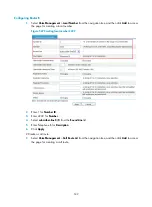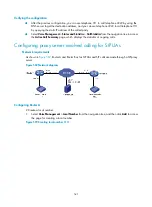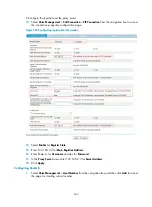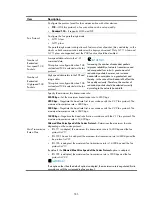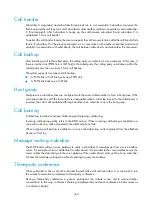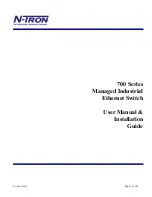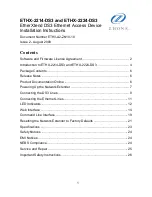
553
or D/A conversion for fax signals (that is, the router demodulates analog signals from PSTN into digital
signals, or modulates digital signals from the IP network into analog signals), but does not need to
compress fax signals.
A real-time fax process consists of five phases:
1.
Fax call setup phase. This phase is similar to the process of a telephone call setup. The difference
is that the fax tones identifying the sending/receiving terminals are included.
2.
Prior-messaging phase. During this phase, fax faculty negotiation and training are performed.
3.
Messaging phase. During this phase, fax packets are transmitted in accordance with the T.4
procedure, and packet transmission is controlled (including packets synchronization, error
detection and correction, and line monitoring).
4.
Post-messaging phase. During this phase, control operations such as packet authentication,
messaging completion, and multi-page continuous transmission are performed.
5.
Fax call release phase. During this phase, the fax call is released.
Introduction to fax methods
T.38 fax
The device supports two fax protocols: T.38 protocol and standard T.38 protocol. The standard T.38
protocol should be selected for interworking with leading fax terminals in the industry. Because most
leading fax terminals in the industry do not support the local training mode, the end-to-end training
mode must be selected for interworking with them.
Pass-through fax
The fax pass-through technology was developed primarily for the purpose of compressing and
transmitting T.30 fax packets that cannot be demodulated through packet switched networks. With this
technology, the devices on two sides can directly communicate over a transparent IP link, and the voice
gateways do not distinguish fax calls from voice calls. After detecting a fax tone in an established VoIP
call, the voice gateway checks whether the voice codec protocol is G.711. If not, the voice gateway
switches the codec to G.711. Then fax data is transmitted as voice data in the pass-through mode.
In the pass-through mode, fax information is in the format of uncompressed G.711 codes and is
encapsulated in RTP packets between gateways, and a fixed bandwidth of 64 Kbps is occupied.
Although the packet redundancy mechanism can reduce the packet loss ratio, the pass-through mode is
subject to factors such as packet loss ratio, jitter, and delay. Therefore, it is necessary to ensure
synchronization of the clocks on both sides. Fax pass-through is called voice band data (VBD) by ITU-T.
That is, fax or modem signals are transmitted over a voice channel using a proper coding method. So far,
the codecs supported are only G.711 A-law and G.711
μ
-law. In addition, when the fax pass-through
function is enabled, the voice activity detection (VAD) function must be disabled to avoid fax failures.
You can implement the fax pass-through function on the voice gateway in two ways:
•
Configure the fax to operate in pass-through mode on both sides.
•
Negotiate the codec as G.711 and disable fax forwarding. Then, disable the VAD function to avoid
fax failures. This method is used for the voice gateway to interwork with other devices in the
pass-through mode.
SIP modem pass-through function
The SIP modem pass-through function is mainly used for remote device management. Because the VoIP
network has replaced part of the traditional PSTN, VoIP devices are required to support the modem
Summary of Contents for MSR SERIES
Page 17: ...xv Documents 835 Websites 835 Conventions 836 Index 838 ...
Page 20: ...3 Figure 3 Initial page of the Web interface ...
Page 42: ...25 Figure 13 Firefox Web browser setting ...
Page 59: ...42 Figure 27 Checking the basic service configuration ...
Page 73: ...56 Figure 35 Sample interface statistics ...
Page 156: ...139 Figure 139 Rebooting the 3G modem ...
Page 168: ...151 Figure 152 Configuring Web server 2 ...
Page 174: ...157 Figure 158 Configure the URL filtering function ...
Page 242: ...225 Figure 233 Enabling the DHCP client on interface Ethernet 0 1 ...
Page 247: ...230 Figure 236 The page for configuring an advanced IPv4 ACL ...
Page 255: ...238 Figure 241 Advanced limit setting ...
Page 298: ...281 e Click Apply 2 Configure Router B in the same way Router A is configured ...
Page 400: ...383 Figure 387 Verifying the configuration ...
Page 405: ...388 ...
Page 523: ...506 Figure 530 Ping configuration page ...
Page 775: ...758 Figure 785 Configuring a jump node ...

